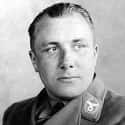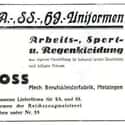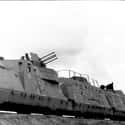-
(#1) Where Did The Amber Room Go?
The Amber Room was an elaborately designed hall in the Soviet Union's Catherine Palace located near St. Petersburg. A gift to Peter the Great from Germany, this unique ornamentation featured amber panels, gold leaf, and mirrors. The rapid advance of the Nazi invasion of 1941 prevented the Russians from removing the panels to safety. They were quickly taken by the Germans and transported to Konigsberg, East Prussia. Initially, the Amber Room was placed on public display at the Konigsberg Castle, but was hidden in anticipation of the 1945 Soviet advance.
While this art masterpiece was never located after the war, most experts believed it was obliterated during the intense shelling that destroyed the Konigsberg Castle. Persistent rumors about the current location of the Amber Room have never panned out.
-
(#2) What Happened To Heinrich Müller?
Heinrich Müller was a senior Nazi Gestapo official who was involved in coordinating political persecution and the Holocaust. He served as an intermediary between Heinrich Himmler and Adolf Eichmann and was an attendee at the infamous Wannsee Conference, the formal adoption of the Final Solution. He personally supervised the arrests and interrogations of the suspects involved in the July 20th plot to kill Hitler.
Last seen in the Bunker on May 1, 1945, Muller was never located. Over time various rumors have circulated concerning collaboration with the Soviets, secret burials in various locations and even a successful escape. He remains the most senior Nazi official to remain officially "missing." -
(#3) Himmler And The Lost SS Rings From The Secret Castle At Wewelsburg
In the early '30s, the forbidding medieval castle at Wewelsburg, Germany became a focal point for Heinrich Himmler and the SS. Himmler believed the castle was an appropriate location to associate himself with the Teutonic kings who had successfully conquered the Slavs. As he already felt he was a reincarnation of a ninth-century Saxon king, Himmler wished to add to this cult of personality by combining ritual and medieval ceremony at Wewelsburg.
He constructed one chamber with 12 pillars and a gas jet for an "eternal flame." Another in the basement was festooned with a giant ornate swastika. The latter was ultimately meant for use as a cremation spot for SS soldiers killed in action.
-
(#4) Rudolf Hess: Murder Or Suicide?
Initially, Rudolf Hess was Hitler's most important political associate and the stenographer for Mein Kampf, written while both were in prison together. However, his erratic behavior and lack of political sophistication quickly consigned him to the outskirts of Hitler's inner circle. Perhaps to regain credibility, Hess attempted a May 1941 one-man peace mission by flying a twin-seat fighter-bomber over England and parachuting on to the property of the Duke of Hamilton, an individual whom Hess had never even met. He was captured and treated as a POW; Germany disavowed the mission.
After the war, he was convicted at Nuremberg, sentenced to life and placed in the Spandau prison. With the passing or release of all his co-defendants in 1987, Hess was 93 and the only remaining inhabitant of Spandau. On August 17, he was found dangling by a lamp cord; it was pronounced that he had taken his own life. Immediately, controversy surrounded this incident and rumors spread – especially one suggesting that the British, worried that Glasnost in Russia would finally allow for Hess's release and for the embarrassing truth to come out about Britain's actual role in negotiations with Germany, had slain Hess.
An alleged suicide note in his pocket turned out to be from a near-fatal health scare in 1989; also, Hess, at his advanced age, could not have possibly lifted himself off the ground. The uproar precipitated two separate reports by the British government, though both were inconclusive.
-
(#5) The Mysterious Passing Of Otto Rahn (The Real Indiana Jones)
Otto Rahn was a writer and researcher who wrote about his conviction that the Holy Grail was secreted away somewhere amidst the ruins of the fortress of Montsegur in the south of France. Rahn incorporated ancient German legends into his works, which came to the attention of Heinrich Himmler – already obsessed with relics and the occult. Himmler personally recruited Rahn into the SS and agreed to sponsor him and his research in hopes that it would lead to the Grail. Unfortunately, Rahn and Himmler were not a good match.
The writer's open homosexuality was problematic on its own, and his failure to locate the Grail, despite expeditions all over Europe, caused Himmler to become disillusioned. In 1937, following Rahn's involvement in a blatant homosexual encounter and criticism of the regime, he was given a 90-day penal assignment to Dachau. He eventually resigned from the SS, a major faux pas that typically did not go unpunished.
Otto Rahn's frozen body was found in the Austrian Tyrol in March 1939 and his mysterious passing has officially been ruled to have been by his own hand.
-
(#6) What Happened To The 'Blutfahne,' The Nazi Ceremonial Relic Flag?
On November 9, 1923, Adolf Hitler led a failed revolt known as the Beer Hall Putsch in Munich. This incident involved an illegal parade and armed confrontation which ended in bloodshed. One of the Nazi participants was carrying an immense swastika flag that fell to the ground and was subsequently covered with the body of a dead Nazi.
The bloodstained flag was retained and presented to Hitler upon his release from prison; it subsequently became a sacred object used to sanctify other Nazi flags at major party rallies. The "Blutfahne" (Blood Flag) even had a special custodian, SS Sturmbannfuhrer Jacob Grimminger, who escorted it during ceremonies. The banner was last seen in public in October of 1944 and then disappeared, its current location unknown.
-
(#7) How Did Hermann Goering Obtain A Cyanide Capsule?
Hermann Goering was convicted by the Nuremberg Tribunal and received a capital sentence. Goering requested that he be shot by firing squad but his request was refused. In October 1946, mere hours away from being hanged, he took his own life with a cyanide capsule.
As he was under intense security, it has remained a mystery how Goering managed to get such contraband in his tiny cell. Claims that Goering hid the capsule himself, either on his person or in some part of his cell, seem unlikely based on the frequency and meticulousness of the searches of his cell. Most likely, he had help from some third party who provided the poison at the last minute. One likely candidate is Lt. Jack Wheelis, a guard known to have received an expensive watch, fountain pen, and autographed photos from the manipulative Reichsmarschall. Goering was rumored to have three separate ampules hidden in his luggage and one in a jar of cold cream. It is believed Wheelis probably disingenuously agreed to retrieve the jar for Goering and may have even tipped him off on the exact date of the execution.
In 2005, a US guard named Herbert Lee Stivers came forward claiming to have supplied Goering with the poison. Though historians said the story was "plausible," they admitted we may never know the truth. Regardless of how it happened, Goering's passing proved a major embarrassment for the Allies.
-
(#8) Did Hitler Kill His Niece, Geli Raubal?
Angela (Geli) Raubal was the daughter of Hitler's half sister, Angela. Hitler first met the 19 year old in 1928 when he employed his half sister at his summer mountain retreat, the Berghof. Nineteen years her elder, Hitler quickly convinced Geli to move into his Munich apartment. There, Hitler controlled her social life, their interaction marked by conflict and dysfunction. Whether their relationship ever became sexual is a controversial contention, but gossip concerning perverted demands by "Uncle Alf" has reverberated throughout history.
On September 18, 1931, Hitler allegedly stormed out of his apartment after yet another violent argument with his niece. The next morning neighbors discovered Geli, dead, shot through the heart. The first police official on the scene, Heinrich Muller, pocketed a letter Geli had been working on when she died. It was ruled that she had taken her own life, and there was no inquest or autopsy. Muller, however, went on to act as chief of the Gestapo.
-
(#9) Martin Bormann: Missing For 53 Years
Martin Bormann was Hitler's personal party secretary and, following the German leader's perishing by his own hand, was intent on breaking out of the Bunker and escaping from the Russians. In the confusion of the battle raging in the streets of Berlin, Bormann joined a small group of Nazi dignitaries attempting to evade Soviet patrols. One of these men, Artur Axmann, was separated from Bormann and SS doctor Ludwig Stumpfegger and, after encountering Russian soldiers, ran back in the direction of Bormann. Axmann claims to have definitely seen the bodies of both Bormann and Stumpfegger, but no trace of Bormann or his body ever emerged.
Bormann was convicted in absentia at Nuremberg and received a capital sentence. In 1963, a former postal worker came forward to claim he had helped bury two bodies in 1945, one of which had Stumpfegger's paybook. Nine years later, two skeletons were excavated near the postal worker's alleged burial spot. Their jaws were imbedded with glass, typical of people who have bit down on a cyanide capsule.
West Germany ultimately declared these to be the remains of Bormann (and Stumpfegger), but skepticism remained until DNA technology allowed for conclusive proof in 1998.
-
(#10) Was The SS Uniform Designed By Hugo Boss?
The good news for those with a few of Hugo's ties in the closet: Boss did not design the striking black couture of Himmler's Death's Head cult. Unfortunately, there's more to the story.
The original Hugo Boss opened a clothing factory near Stuttgart in 1924 and supplied the Nazi party from its earliest days with predesigned clothing from templates. Boss supplied similar types of clothing to other organizations, but he also joined the Nazi Party in 1931. Business boomed and Boss advertised his firm as an official supplier of SS Uniforms. Business got even better when Boss received contracts to manufacture military uniforms. During wartime he employed forced labor in deplorable conditions that were ultimately sanctioned in postwar proceedings. Boss died in 1948, but, in 2011, the fashion firm publicly apologized for Boss's Nazi sympathies and ties.
-
(#11) How Did Corneilus Gurlitt Come To Possess A Collection Of Looted Nazi Art?
Cornelius Gurlitt was the son and grandson of two celebrated German art historians. In 2010, carrying large amounts of cash, he was stopped by customs officials on a train between Zurich and Munich. He did not mention a Munich residence and subsequent investigations determined he was unmarried, had no pension, no source of income, and no tax or health registration. Though he had not done anything illegal, he certainly seemed suspicious.
In February of 2012, German officials, still investigating him for possible tax evasion, executed a search warrant on his apartment, confiscating 121 framed and 1,258 unframed artworks in Gurlitt's modest Munich abode. The collection varied from old world masters to modern pieces. Gurlitt refused to cooperate or even explain how such a collection came into his possession. While it seemed obvious many of the paintings must have been confiscated by the Nazis, it would be a year before news of the find became public, precipitating a sensation.
Gurlitt maintained that his father, Hildebrand, an art dealer associated with the degenerate art auctions of the Nazis, had acquired every single painting legitimately and vowed to fight to keep the collection. Immediately, it was determined that numerous works belonged to victims of the Nazis.
In April 2014 Gurlitt and the government reached a compromise: The collection would be returned to him, provided he assisted in the process of figuring out which pieces were stolen. However, Gurlitt passed away a month later, listing the Museum of Fine Arts Bern as his sole heir. The museum has maintained that it will not accept any ill-gotten Nazi art, but the process of identifying the actual ownership of many of the paintings remains a work in progress.
-
(#12) Is The Nazi 'Ghost Train' Hidden In A Tunnel in Poland?
As the Nazis retreated from territory conquered early in World War II, they were always faced with the same quandary: what to do with all of the valuables, artwork, and jewelry taken from the conquered? In Poland, it is rumored that in the final days of the war, local German officials near Breslau (now Wroclaw) stuffed an armored train with such booty and headed toward secret tunnels located in the Owl mountains. Somewhere along the way the train disappeared, rumored to be sealed in a mountain tunnel in an unknown location.
Locals have hunted the Ghost Train for many years to no avail, but an official claim by two treasure hunters in 2015 rekindled the mystery. Through a lawyer, Piotr Koper and Andreas Richter claimed to have seen the train and its gold and have promised to lead officials of the Polish town of Walbrzych to its location, in return for 10 percent of the spoils.
In December 2015 researchers from Krakow University of Science and Technology said there was no evidence the train exists at the site, but Koper and Richter remain convinced.
New Random Displays Display All By Ranking
About This Tool
Our data comes from Ranker, If you want to participate in the ranking of items displayed on this page, please click here.






















